Travel: Tarn, France


She’s too shy to speak to us in English – her companion translates for us – but she clearly understands our questions, and as we marvel at all manner of items from the family’s past, such as little Henri’s sketches, baby shoes, bicycle and the wall on which children’s heights were measured (the poor boy never reaches five feet) she potters around, dusting corners and flicking the odd dead fly out of the window.
He would have inherited this place had he not died so young, syphilitic and alcoholic, aged 36. But it would be wrong to suggest that his disabilities, health problems, challenging family life and later arguably seedy lifestyle made for an unhappy man. Henri de Toulouse-Lautrec was funny, naughty and charismatic, as our tour around the French region of Tarn will prove.
Advertisement
Hide AdThe chateau is just outside Tarn, an area rich in Lautrec history (and, of course, heartbreakingly good wine and food). There is a lot to see in quite a small radius. The capital, Albi, a half-hour drive from Toulouse, is an exquisite little town and Unesco World Heritage Site that straddles the Tarn river. It is dominated by the Cathedrale Sainte-Cécile, just around the corner from Lautrec’s birthplace, and one of the largest brick structures in the world, in which you could easily lose a day revelling in its detail. It’s also definitely worth visiting the recently renovated Toulouse-Lautrec Museum, set up shortly after his death thanks largely to his lifelong friend, art dealer Maurice Joyant, which is located in the bishop’s palace, the Palais de la Berbie.
Now housing more than 1,000 art works, the museum takes us through Lautrec’s extraordinary life. His aristocratic parents were first cousins (his father a delightfully eccentric sort who was fond of fancy dress and perhaps not the best husband), and years of in-breeding before that meant the artist’s bones were so crumbly that he broke both legs in separate accidents as a young teenager, and was prone to illness. So when his posh friends and family were larking about the countryside, he sought solace with pencil and paints and one heck of an imagination.
Many of his famous paintings and drawings of prostitutes in Paris can be viewed here. He first gained access to their intimate lives when he went along with his cousin, a comparatively prudish doctor who was obliged to give them health checks. Over time, he made many friends – and took one or two lovers – among the sex workers who adored him for his wit.
Also on display are many of his posters for Paris cabarets, which he painted for money rather than from any artistic compulsion. Closer inspection rewards the viewer with hilarious stories of grudges, cattiness and amusing one-upmanship among the turn-of-the- century luvvies. Unfortunately, Lautrec’s childhood home in Albi is not open to the public, but we did manage to have a traditional Tarn lunch at Le Lautrec, a restaurant housed in what used to be the family’s stables, round the back.
Albi certainly punches above its weight when it comes to food. L’epicurien, for example, provides a fresh, stylish, modern European take on French cuisine, courtesy of charismatic Swedish chef Rikard Hult, and the Michelin-starred L’esprit du Vin boasts a simply extraordinary alchemy of flavours and colours under the expertise of former medical man David Enjalran. Fans of serious cooking should also make an effort to eat at the Michelin-starred Chateau de Salettes, half an hour’s drive away. It’s in a 16th-century castle, set within a vineyard, and has been updated with a very stylish blend of contemporary design. The food is simply astounding. The wine from this region, Gaillac, is pretty special too. Thanks to the large variety of grapes here, the white, red, rose and sparkling varieties are all very, very drinkable. And Gaillac is a lovely word to pronounce, thanks to the Tarn accent, which lets you say that final ‘c’ out loud so it sounds like ‘guyack’. Other words sound different too. ‘Pain’ (bread), for example, sounds a bit like ‘ping’ here.
Another treat for foodies can be found in the nearby town of Castres, which has the kind of open-air market that makes so many people fall in love with France. It is bursting with mouthwatering fresh fruit and vegetables, cheeses, seafood and a local speciality, rose garlic.
Advertisement
Hide AdDuring the middle ages, Castres’ economy focused on textiles, and sweatshops lined the river Agoût. These buildings are now pretty low-cost apartments, and their higgledy-piggledy colourfulness is beguiling.
Art lovers should take a few hours to visit the Goya and Spanish Art Museum in Castres. Although the name suggests it should contain more works by Goya than it actually does, it boasts some impressive works by Velásquez, Murillo and Zurbana.
Advertisement
Hide AdIf you have time, you really must visit Cordes-sur-Ciel, a fortified mountain village that dates back to 1222. Once you’re through the imposing brick walls you discover an elegant settlement with hanging gardens, fig and almond trees.
We were lucky enough to stay at La Reserve in Albi, a smart but intimate hotel (and hangout of many a celeb) with views over green fields and the river Tarn. Thanks to the mild climate in this part of France, supper under the stars by the pool isn’t a problem in autumn. But just in case we felt a chill, the staff brought us some special blankets while we sipped our Gaillac.
• La Reserve (www.lareservealbi.com), prices from £312.
• Jet2.com flies direct from Edinburgh and Glasgow to Toulouse from May to September, from around £95. Year-round flights are available from London with various carriers including British Airways and Easyjet, from around £119.